 Come, human female. We will go to my crib and get to know each other better. 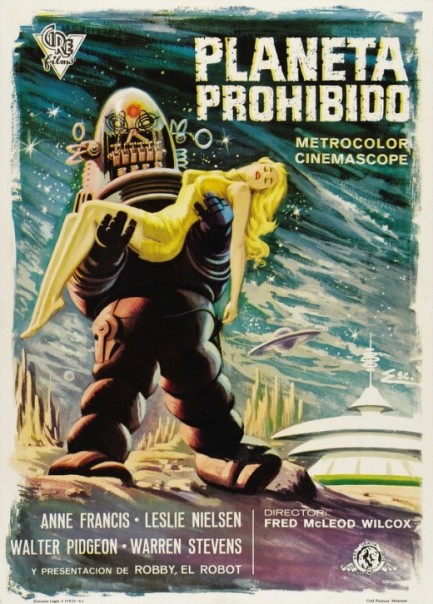
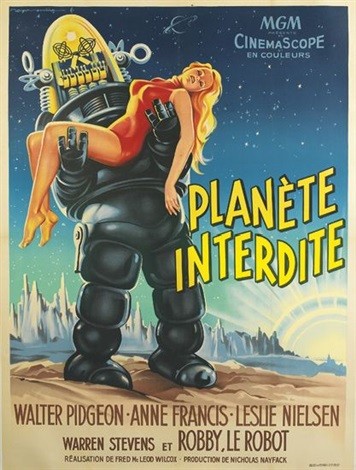 Spanish artist Carlos Escobar painted this poster for the sci-fi flick Planeta prohibido, better known as Forbidden Planet, which premiered in the U.S in 1956 and reached Spain today in 1957. Escobar was a master of realistic figures, such as those he painted of Sharon Tate and Beba Lončar, but for this piece he used a more stylized technique to depict Robby the Robot and an unconscious figure we suppose is Anne Francis. We don't remember Robby carrying her in the film, but it's been a while since we watched it, so maybe we've spaced that. But in any case this is a fantastic piece of promo art. We especially love the trippy sky. It reminds us of this time we dropped acid in Bryce Canyon National Park. Spanish artist Carlos Escobar painted this poster for the sci-fi flick Planeta prohibido, better known as Forbidden Planet, which premiered in the U.S in 1956 and reached Spain today in 1957. Escobar was a master of realistic figures, such as those he painted of Sharon Tate and Beba Lončar, but for this piece he used a more stylized technique to depict Robby the Robot and an unconscious figure we suppose is Anne Francis. We don't remember Robby carrying her in the film, but it's been a while since we watched it, so maybe we've spaced that. But in any case this is a fantastic piece of promo art. We especially love the trippy sky. It reminds us of this time we dropped acid in Bryce Canyon National Park.
Interestingly, French artist Roger Soubie painted an almost identical promo, which you see here also. We can only assume the studio dictated the look of the poster and each artist expressed their personal style with the backgrounds. Why not use the same poster in both Spain and France? We don't know the answer to that. We can't help but think it would have been more economical than paying two artists to reproduce the same basic image. But it's fine with us, because all these years later we have two top shelf promos to admire. As a bonus, we've uploaded a Robby and Anne Francis promo photo below. For a robot, Robby's got game. Leslie Nielsen better be careful or the far reaches of the galaxy are going to get a lot colder. 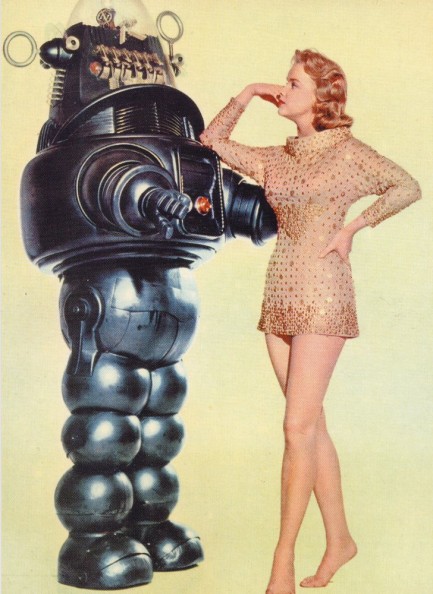
 Virtuoso poster artist finds inspiration in Serb star. 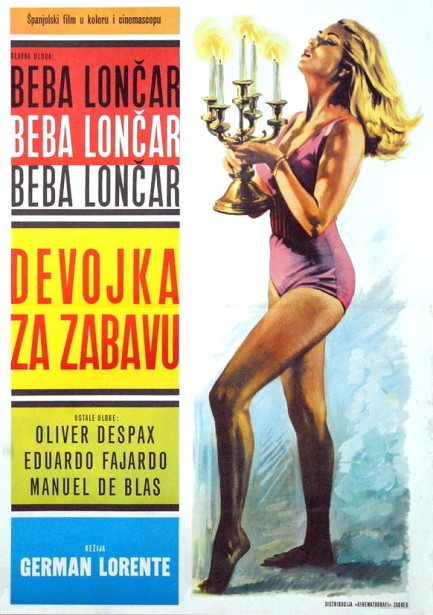
Above you see a poster from the former Yugoslavia, in Serbo-Croatian (we think), for the film Devojka za zabavu, starring Beba Lončar. We haven't watched this, so no summary, but it's available should you feel the urge. We're primarily interested in the art. The poster says this is a Španjolski film, or Spanish film, and indeed it was originally made in Spain as Amor en un espejo, and titled in the U.S. Cover Girl. The poster was adapted from the Spanish promo art painted by Carlos Escobar, who signed his work as Esc. On the Spanish version his signature is prominent, but the Yugoslavians decided to wipe it out for some reason. We already showed one example of Escobar's talent featuring Sharon Tate, and it may be one of the most beautiful of the hundreds of posters to adorn Pulp Intl. over the years. This one, which uses the lovely Lončar as a model, is also good. Evidence of what a big star the Serb actress was in her native Yugoslavia exists in her name, thrice repeated above the film's title, which is not how the Spanish poster was set up. Check out the Tate promo here. And check out Lončar here. Amor en un espejo premiered in Spain today in 1968.
 Tate gives chase in an international fortune hunting comedy about a missing chair. 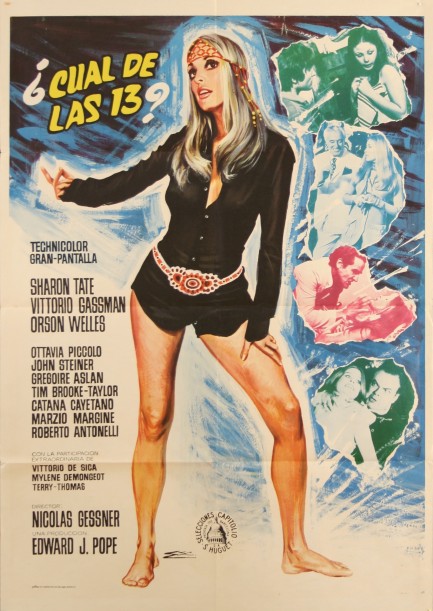
In ¿Las cual de 13?, aka 12 + 1, aka Twelve Plus One, an Italian barber played by Vittorio Gassman inherits thirteen chairs and, deeming them useless, sells them to a London antique shop. He later discovers one of the chairs contains a fortune, but when he returns to the shop he's told they've all been sold. So he offers the antique shop employee Sharon Tate half of the fortune to help him track down the chairs, which of course have scattered to the four winds. Their search takes them to Paris, Rome, and beyond, in 1960s screwball fashion with its expected pratfalls, mix-ups, and sticky situations. Gassman and Tate do reasonable jobs with the goofy script that's been made of Soviet authors Ilf and Petrov's satirical source novel, and the film is boosted by appearances from Vittorio De Sica, Mylène Demongeot, Terry-Thomas, and Orson Welles. This was an Italian production, but the poster above was painted for the film's Spanish run by Carlos Escobar, who signed his work “Esc.” This is the best we've ever seen from a very good artist. Since the movie didn't premiere in Italy until after Tate had been slain this month in 1969, and didn't reach Spain until mid-1970, the poster very likely was painted post-murder, which means Escobar probably was thinking of how to best portray someone who'd become a tragic figure. We suspect he put special effort into his work as a tribute, and if so, a fitting tribute it was. 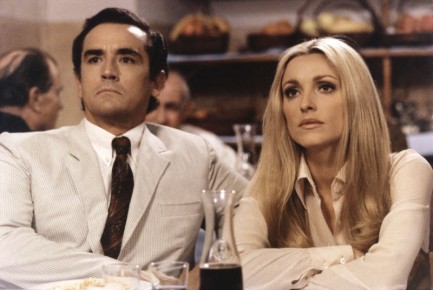 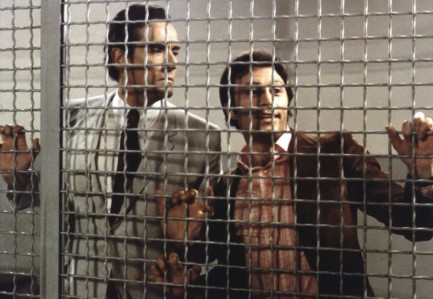 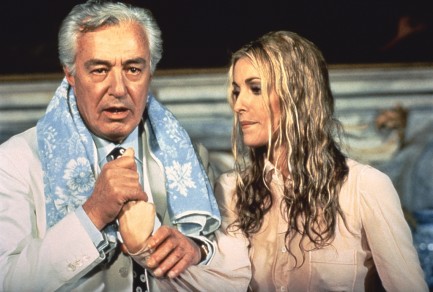 
|
 |

The headlines that mattered yesteryear.
2003—Hope Dies
Film legend Bob Hope dies of pneumonia two months after celebrating his 100th birthday. 1945—Churchill Given the Sack
In spite of admiring Winston Churchill as a great wartime leader, Britons elect
Clement Attlee the nation's new prime minister in a sweeping victory for the Labour Party over the Conservatives. 1952—Evita Peron Dies
Eva Duarte de Peron, aka Evita, wife of the president of the Argentine Republic, dies from cancer at age 33. Evita had brought the working classes into a position of political power never witnessed before, but was hated by the nation's powerful military class. She is lain to rest in Milan, Italy in a secret grave under a nun's name, but is eventually returned to Argentina for reburial beside her husband in 1974. 1943—Mussolini Calls It Quits
Italian dictator Benito Mussolini steps down as head of the armed forces and the government. It soon becomes clear that Il Duce did not relinquish power voluntarily, but was forced to resign after former Fascist colleagues turned against him. He is later installed by Germany as leader of the Italian Social Republic in the north of the country, but is killed by partisans in 1945.
|

|
|

It's easy. We have an uploader that makes it a snap. Use it to submit your art, text, header, and subhead. Your post can be funny, serious, or anything in between, as long as it's vintage pulp. You'll get a byline and experience the fleeting pride of free authorship. We'll edit your post for typos, but the rest is up to you. Click here to give us your best shot.

|
|


 Spanish artist Carlos Escobar painted this poster for the sci-fi flick Planeta prohibido, better known as Forbidden Planet, which premiered in the U.S in 1956 and reached Spain today in 1957. Escobar was a master of realistic figures, such as those he painted of Sharon Tate and Beba Lončar, but for this piece he used a more stylized technique to depict Robby the Robot and an unconscious figure we suppose is Anne Francis. We don't remember Robby carrying her in the film, but it's been a while since we watched it, so maybe we've spaced that. But in any case this is a fantastic piece of promo art. We especially love the trippy sky. It reminds us of this time we dropped acid in Bryce Canyon National Park.
Spanish artist Carlos Escobar painted this poster for the sci-fi flick Planeta prohibido, better known as Forbidden Planet, which premiered in the U.S in 1956 and reached Spain today in 1957. Escobar was a master of realistic figures, such as those he painted of Sharon Tate and Beba Lončar, but for this piece he used a more stylized technique to depict Robby the Robot and an unconscious figure we suppose is Anne Francis. We don't remember Robby carrying her in the film, but it's been a while since we watched it, so maybe we've spaced that. But in any case this is a fantastic piece of promo art. We especially love the trippy sky. It reminds us of this time we dropped acid in Bryce Canyon National Park.












































































